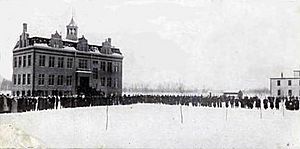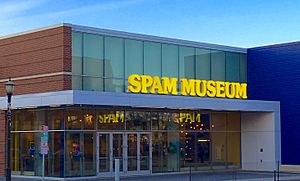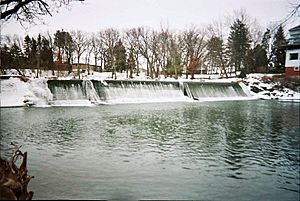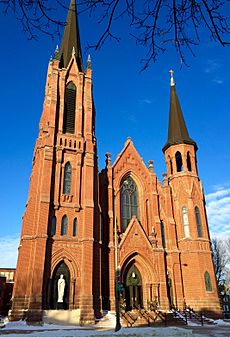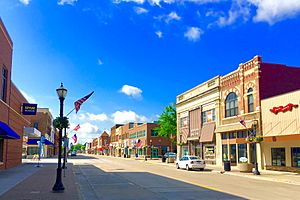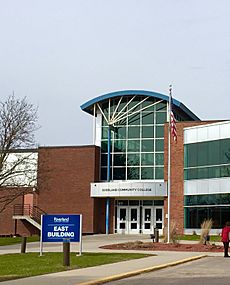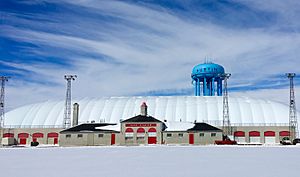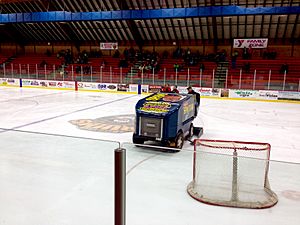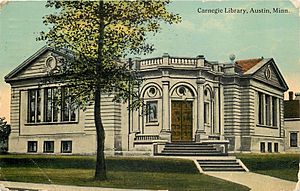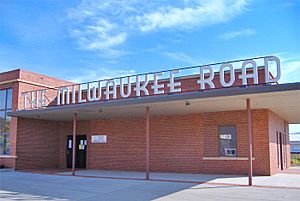Austin, Minnesota facts for kids
Quick facts for kids
Austin
|
||
|---|---|---|
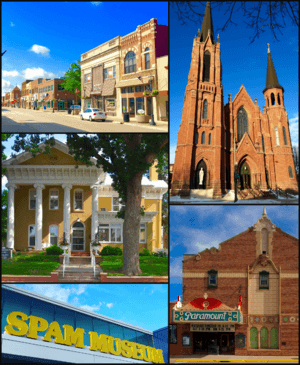
Clockwise from top: day city,ca St. Augustine's Church, Paramount Theater, Spam Museum, Hormel Historic Home
|
||
|
||
| Nickname(s):
SPAM Town USA
|
||
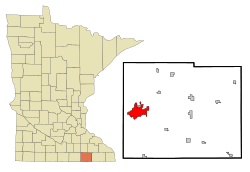
|
||
| Country | United States | |
| State | Minnesota | |
| County | Mower | |
| Established | 1853 | |
| Incorporated | 1856 | |
| Area | ||
| • Total | 13.19 sq mi (34.15 km2) | |
| • Land | 13.08 sq mi (33.88 km2) | |
| • Water | 0.11 sq mi (0.27 km2) | |
| Elevation | 1,204 ft (367 m) | |
| Population
(2020)
|
||
| • Total | 26,174 | |
| • Density | 2,001.1/sq mi (772.6/km2) | |
| Time zone | UTC-6 (CST) | |
| • Summer (DST) | UTC-5 (CDT) | |
| ZIP code |
55912
|
|
| Area code(s) | 507 | |
| FIPS code | 27-02908 | |
Austin is a city in, and the county seat of, Mower County, Minnesota, United States. The population was 26,174 at the 2020 census. The town was originally settled along the Cedar River and has two artificial lakes, East Side Lake and Mill Pond. It was named for Austin R. Nichols, the area's first European settler.
Hormel Foods Corporation is Austin's largest employer, and the town is sometimes called "SPAM Town USA". Austin is home to Hormel's corporate headquarters, a factory that makes most of North America's SPAM tinned meat, and the Spam Museum. Austin is also home to the Hormel Institute, a leading cancer research institution operated by the University of Minnesota with significant support from the Mayo Clinic.
In 2015 Austin was named one of the "Top 10 Affordable Small Towns Where You'd Actually Want to Live" and one of the "Best Small Cities in America".
Contents
History
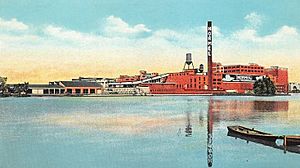
Fertile land, trapping, and ease of access brought first trappers and then the early pioneers to this region. The rich gameland attracted a trapper named Austin Nichols, who built the first log cabin in 1853. At that time there were "about twenty families in the area." More settlers began to arrive by wagon train in 1855, and by 1856, enough people were present to organize Mower County. It was in 1856 that the settlement adopted the name Austin, in honor of its first settler. That year the first hotel opened to travelers and the first physician moved to town, Dr. Ormanzo Allen. The first newspaper, the Mower County Mirror, was started in 1858.
Mills, powered by the Cedar River, were the first industries in Austin. They provided much-needed flour and lumber for the growing village. Growth was slow during the first two decades, but the Chicago, Milwaukee, and St. Paul railroad arrived in the late 1860s, hastening economic development. The town's first schoolhouse was constructed in 1865 and the first bank opened its doors the following year.
In 1891, George A. Hormel opened a small family-owned butcher shop in Austin,
Austin received its first college in 1897 when the Southern Minnesota Normal College and Austin School of Commerce were opened by Charles Boostrom. The college closed in 1925 and the city was without an institution of higher education until Austin Junior College opened in 1940 (In 1964 it became part of the State College and University System and is now Riverland Community College).
A 50-acre parcel of land was made into Horace Austin State Park by the Minnesota Legislature in 1913. At the time, the land was "one of the beauty spots of Southern Minnesota, but of late years has not been cared for and in places the banks have been disfigured by dumping along the shore of the stream," according to the bill's author, Senator Charles F. Cook. The park was converted to a state "scenic wayside" in 1937, then transferred to city ownership in 1949.
In the 1930s, Austin Acres was built with funding from the Subsistence Homesteads Division of the Department of the Interior, and the Austin Parks Board was formed in the 1940s to oversee the growing number of green spaces within the city.
The Jay C. Hormel Nature Center, established in 1971, a 500-acre nature preserve also including the 60 acre Hormel Arboretum, purchased from Geordie Hormel with a state grant. In 1973, the city opened Riverside Arena, the city's first indoor ice arena, now home to a variety of ice activities including the Austin Bruins junior ice hockey team.
In August 1985, 1,500 Hormel meatpackers went on strike at the Austin plant after management demanded a 23% cut in wages. A protracted battle between union employees and Hormel continued until June 1986, one of the longest labor struggles of the 1980s. In January 1986, some workers crossed the picket lines, leading to riots; the conflict escalated to such a point that the National Guard was called in by governor Rudy Perpich to keep the peace. The strike received media attention on a national level and a documentary film, American Dream, was made during the ten-month long conflict. The movie was released in 1990 and went on to win the Best Documentary Feature at the 63rd Annual Academy Awards. A song about the strike, entitled "P-9", was written by Dave Pirner of the Minneapolis band Soul Asylum. The song can be found on their 1989 album, Clam Dip & Other Delights. Hormel never gave in to the workers' demands, and when the strike ended in June 1986, 700 employees were left without work.
Present day
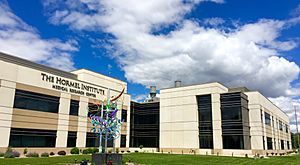
Austin has recently undergone several notable developments: a new $28 million courthouse and jail were completed in 2010, a new intermediate school opened in 2013, and a major redevelopment project is taking place at the site of the former Oak Park Mall.
The city is currently embarking on a community development project called Vision 2020. This grassroots movement was chartered in 2011 to implement ten major new community initiatives that could be completed by the year 2020. The projects involve a variety of projects related to economic development, heath and wellness, education, and tourism. A community recreation center is in progress as well as a tourism and visitor center. One of the stated goals including making the downtown business district more of a destination, aided in part by the relocation of the Spam Museum to Main Street in 2016.
In 2015, the National Association of Realtors named Austin one of the "Top 10 Affordable Small Towns Where You'd Actually Want to Live."
Major floods
Austin has a long history of flooding. The Cedar River, along with Dobbins Creek and Turtle Creek, flow through the community, and many homes and businesses were constructed in flood plains. A series of floods between 1978 and 2010 resulted in a major flood mitigation program. This program involved the purchase and demolition of buildings within the flood plain, converting low-lying areas of town to parks, and the installation of a flood wall to protect downtown.
After two major floods occurred in July 1978, city officials and local residents decided to take action. Locals organized the Floodway Action Citizens Task Source (FACTS), who met with local and state leaders, as well as members of the Army Corps of Engineers, but it was decided that major flood prevention measures would not be cost-effective. However, a Community Development Block Grant was won from the Department of Housing and Urban Development, allowing for the buyout of homes lying in the flood plain. City planners also vowed to no longer build new structures in the existing flood plains. In 1983 and 1993, major floods again brought damage to many homes and businesses in Austin. Over 400 homes were affected and a new round of buyouts took place through the Hazard Mitigation Grant Program (HMGP).
The worst flooding on record came several years later when the Cedar River crested at 23.4 feet in the spring of 2000. Many of the worst-hit parts of town were now void of homes and businesses but there was still damage and extensive clean-up required. Flooding came again in September 2004, resulting in two fatalities. Additional protection (dikes) were added along the Cedar River as a result.
The most recent round of serious flooding came in 2010, after which a plan was developed for a permanent flood wall to protect downtown from the floodwaters of the Cedar River and Mill Pond. The wall was completed in 2014.
Major tornadoes
On 20 August 1928, an F-2 sized tornado touched down on Winona Street (1st Ave). The damage ran from the southern edge of Austin High School to the Milwaukee Road railyards on the city's east side. Buildings ruined or damaged included St. Olaf Lutheran Church, Carnegie Library, Main Street, the spire on Austin's former courthouse, Grand Theatre (replaced in 1929 with what is now the Paramount Theatre), Austin Utilities, Lincoln School, and several boxcars at the Milwaukee railyards before it dissipated. Austin residents noticed debris raining out of the sky, such as straw and laundry.
Another F-2 touched down in August 1961, at 808 18th St. S.W. It quickly gained strength once on the ground, become an F-3 at 17th St. S.W., where it destroyed a garage. The twister lifted briefly, touching down in the city fairgrounds and hitting the grandstand roof, tearing off parts and damaging beams.
In the summer of 1984, a tornado destroyed Echo Lanes Bowling Alley as it swept through the S.E. part of Austin. Neighboring Bo-Dee Campers had suffered considerable damage as well. The tornado also destroyed Schmidt TV.
A disputed tornado or straight line winds took down massive amounts of branches and trees on 27 June 1998, uprooting smaller trees and knocking large branches across streets. Several side streets in the northwest quarter of the city became impassable, as well as 8th Ave northwest (near Sumner Elementary School), and 14th St. Northwest (between I-90 and 8th Ave). The event caused disruption in Sunday church services the next morning, and many congregations organized clean up activities instead of regularly scheduled events.
A tornado touched down in Glenville on 1 May 2001, gaining strength before it turned into a F-3 headed for Austin. While the twister dissipated shortly after hitting town, notable damage occurred in both cities.
On 17 June 2009, an EF2 tornado touched down outside of Austin and moved across the northwest and northern parts of the city, gradually weakening as it moved east. The worst damage in Austin was about three miles north of downtown. The Visitors Center at the Jay C. Hormel Nature Center sustained damage, with the nature preserve losing some 300 trees. There were a few minor injuries.
Geography
According to the United States Census Bureau, the city has a total area of 11.90 square miles (30.82 km2), of which 11.79 square miles (30.54 km2) is land and 0.11 square miles (0.28 km2) is water. Its elevation is approximately 1,200 ft (370 m).
Climate
Austin has a humid continental climate typical of the Upper Midwest. Winters are cold and snowy, while summers are warm with moderate to high humidity. On the Köppen climate classification, Austin falls in the humid continental climate zone (Dfa) and is situated in USDA plant hardiness zone 4b. Below is a table of average high and low temperatures throughout the year in Austin.
| Climate data for Austin, Minnesota (55912) | |||||||||||||
|---|---|---|---|---|---|---|---|---|---|---|---|---|---|
| Month | Jan | Feb | Mar | Apr | May | Jun | Jul | Aug | Sep | Oct | Nov | Dec | Year |
| Average high °F | 22 | 27 | 39 | 56 | 68 | 78 | 81 | 78 | 71 | 58 | 41 | 26 | 53.8 |
| Average low °F | 4 | 9 | 22 | 35 | 47 | 57 | 61 | 58 | 49 | 37 | 24 | 10 | 34.4 |
| Average precipitation inches | 0.91 | 0.83 | 1.89 | 3.54 | 4.33 | 4.88 | 4.76 | 4.41 | 3.46 | 2.36 | 1.93 | 1.22 | 34.52 |
| Average high °C | −6 | −3 | 4 | 13 | 20 | 26 | 27 | 26 | 22 | 14 | 5 | −3 | 12.1 |
| Average low °C | −16 | −13 | −6 | 2 | 8 | 14 | 16 | 14 | 9 | 3 | −4 | −12 | 1.3 |
| Average precipitation mm | 23 | 21 | 48 | 90 | 110 | 124 | 121 | 112 | 88 | 60 | 49 | 31 | 877 |
| Source: U.S. Climate Data | |||||||||||||
Demographics
| Historical population | |||
|---|---|---|---|
| Census | Pop. | %± | |
| 1860 | 200 | — | |
| 1870 | 2,039 | 919.5% | |
| 1880 | 2,305 | 13.0% | |
| 1890 | 3,901 | 69.2% | |
| 1900 | 5,474 | 40.3% | |
| 1910 | 6,960 | 27.1% | |
| 1920 | 10,118 | 45.4% | |
| 1930 | 12,276 | 21.3% | |
| 1940 | 18,307 | 49.1% | |
| 1950 | 23,100 | 26.2% | |
| 1960 | 27,908 | 20.8% | |
| 1970 | 25,074 | −10.2% | |
| 1980 | 23,020 | −8.2% | |
| 1990 | 21,907 | −4.8% | |
| 2000 | 23,314 | 6.4% | |
| 2010 | 24,718 | 6.0% | |
| 2020 | 26,174 | 5.9% | |
| U.S. Decennial Census 2018 Estimate |
|||
In 2000 there were 23,314 people, 9,897 households, and 6,076 families residing in the city and 10,261 housing units. The racial makeup of the city was 92.6% White, 0.81% African American, 0.18% Native American, 2.22% Asian, 0.02% Pacific Islander, 3.09% from other races, and 1.09% from two or more races. Hispanic or Latino of any race was 6.12% of the population. There were 9,897 households, out of which 27.2% had children under the age of 18. The average household size was 2.29; the average family size was 2.90. The median income for a household in the city was $33,750, and the median income for a family was $42,691. Males had a median income of $31,787 versus $23,158 for females. The per capita income for the city was $20,651. About 7.5% of families and 10.9% of the population were below the poverty line.
2010 census
As of the census of 2010 there were 24,718 people, 10,131 households, and 6,114 families residing in the city. The population density was 2,096.5 inhabitants per square mile (809.5/km2). There were 10,870 housing units at an average density of 922.0 per square mile (356.0/km2). The racial makeup of the city was 86.8% White, 3.0% African American, 0.3% Native American, 2.4% Asian, 0.2% Pacific Islander, 4.8% from other races, and 2.4% from two or more races. Hispanic or Latino of any race were 15.4% of the population.
There were 10,131 households, of which 30.2% had children under the age of 18 living with them, 43.9% were married couples living together, 11.1% had a female householder with no husband present, 5.3% had a male householder with no wife present, and 39.7% were non-families. 33.4% of all households were made up of individuals, and 15.9% had someone living alone who was 65 years of age or older. The average household size was 2.39 and the average family size was 3.05.
The median age in the city was 37. 25.6% of residents were under 18; 8.8% were between 18 and 24; 24.3% were from 25 to 44; 23.5% were from 45 to 64; and 17.7% were 65 or older. The city was 49.2% male and 50.8% female.
Arts and culture
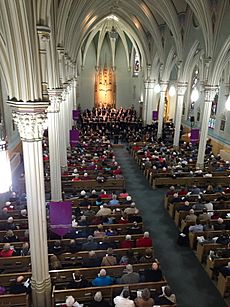
Music
Austin is home to several long-standing performing arts organizations, including the Austin Symphony Orchestra, which was established in 1957.). Austin has also produced many professional musicians of regional and national acclaim, including John Maus, Trace Bundy, Charlie Parr, Martin Zellar, and Molly Kate Kestner.
In 2015, the MacPhail Center for Music, based in Minneapolis, Minnesota, opened their first outstate location in Austin. Currently located at Riverland Community College, MacPhail's Austin campus provides individual instruction on nearly a dozen musical instruments for adults and children, as well as large ensembles and early childhood music instruction.
Theater
The Frank W. Bridges Theatre is home to an active theatre program at Riverland Community College, while Matchbox Children's Theatre, established in 1975, provides shows year-round for both adults and children.
ArtWorks Center
The Austin ArtWorks Center, established in 2014, hosts gallery exhibits, educational classes, performance space, and a retail gallery. The Center is operated by the Austin Area Commission for the Arts, which also sponsors the Austin ArtWorks Festival, an annual celebration of visual, performing, and literary arts. The Center is located in the historic First National Bank Building, which opened in 1896.
Architecture
There are several historically and architecturally significant buildings in Austin, including Austin High School, St. Augustine's Church, Roosevelt Bridge, the Historic Paramount Theatre, the Hormel Historic Home, the Arthur W. Wright House, and several blocks of historic downtown buildings on Main Street. Austin is also home to a Frank Lloyd Wright home, the Elam Residence.
Places of interest
- Mower County Fairgrounds and Mower County Fair
- Buffy the Cow
- SPAM Museum
- Jay C. Hormel Nature Center
- Hormel Historic Home
- St. Augustine's Church
- Austin ArtWorks Center
- Austin High School and Knowlton Auditorium
- Mower County Historical Society
- Historic Paramount Theatre
- Sola Fide Observatory
- East Side Lake
- Bandshell Community Park
- Todd Park
- Austin Country Club (private)
- Meadow Greens Golf Course (public)
- The Elam House (Frank Lloyd Wright home)
- Christ Episcopal Church
- Packer Dome (seasonal)
- Vintage Bicycle Collection at Rydjor Bike Shop
- Hormel Institute
- Roosevelt Bridge
Parks and recreation
Austin has an extensive network of 28 parks and green spaces, which the Department of Parks, Recreation, and Forestry oversees. These range from small, passive spaces like Sterling Park (manicured but lacking recreational equipment) to the 507-acre Jay C. Hormel Nature Center.
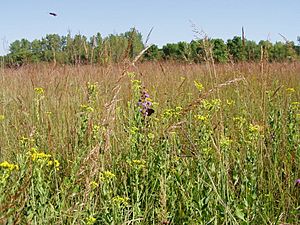
Jay C. Hormel Nature Center Established in 1971, the Hormel Nature Center is located in Western Mower County within the city limits of Austin. The Nature Center features restored and remnant prairie, hardwood forest, wetlands and meandering streams. There are more than ten miles of trail, giving visitors the opportunity to see deer, mink, raccoons, salamanders, many different birds and other native wildlife. It features an Interpretive Center, open daily, where visitors can learn about the history and biology of the area through hands-on exhibits, interactive displays and live educational animals. The Nature Center offers equipment rental throughout most of the year: canoes and kayaks in the summer months and cross country skis and snowshoes while snow conditions are good.
Other parks Horace Austin Park, in downtown, is the most centrally located and boasts a blend of modern amenities, including playground equipment and the municipal pool as well as trails and green spaces surrounding Mill Pond. Austin's parks are located throughout all four quadrants of the city and many are connected by a trail system, including three of the largest parks in Austin: Bandshell Community Park, Driesner Park, and Todd Park. Todd Park is a popular summer recreation space, with several sand volleyball courts and 11 softball and baseball diamonds.
Bandshell Community Park is the site of Austin's annual Independence Day celebration, which draws thousands of residents for two days of music, carnival games, and evening fireworks.
Economy
With Hormel's corporate headquarters and main production facility in Austin, food processing plays a dominant role in the city's economy. Hormel and Quality Pork Processors, a contract food processing firm serving Hormel, are by far the city's largest private employers. Though most famous for SPAM, Hormel also produces many other brands, such as Jennie-O turkey, Muscle Milk, Skippy peanut butter, and Dinty Moore beef stew.
The government, education, hospitality, and retail sectors comprise much of the remainder of Austin's employment base.
Hormel's consistent and steady growth have resulted in below-average unemployment rates for Austin and Mower County in recent years. As of February 2016 the unemployment rate was 3.7% in Austin and Mower County, below both the state and national average.
Austin-area businesses and community actively supported an application to participate as a test community in the Google Fiber project, begun in 2010. Though unsuccessful in their bid, the adoption of high-speed fiber optic and wireless internet throughout Austin is one of the Vision 2020 committee's goals.
Austin's retail business struggled during the Great Recession, including the demise of the Oak Park Mall. As of 2017 the business climate had improved, including a major redevelopment of the former mall site. Downtown remains vibrant as well, including construction of a new SPAM Museum in 2016.
Top employers
According to Austin's Comprehensive Annual Financial Report (2016), the top employers in the city are:
| # | Employer | # of Employees |
|---|---|---|
| 1 | Hormel Foods | 2,693 |
| 2 | Quality Pork Processors | 1,260 |
| 3 | Mayo Clinic Health System | 970 |
| 4 | Austin Public Schools | 885 |
| 5 | Hy-Vee | 365 |
| 6 | Walmart | 350 |
| 7 | Cedar Valley Services | 310 |
| 8 | Mower County | 287 |
| 9 | Gerard Academy | 244 |
| 10 | Riverland Community College | 177 |
Sports
The Austin Bruins are a North American Hockey League team that began play during the 2010–11 season. The team finished 1st in the Central Division in the 2012–13, 2013–14, and 2014–15 seasons, and advanced to the Robertson Cup Finals in 2014 and 2015, though ultimately losing the championship both times. The Bruins play their home games at Riverside Arena. Austin previously was represented in Junior hockey by the Austin Mavericks, a team that first participated in the Midwest Junior Hockey League from 1974 to 1977 and following a league merger competed in the United States Hockey League from 1977 to 1985.
Austin is home to two amateur baseball clubs, the Austin Blue Sox and Austin Greyhounds. The Riverland Community College Blue Devils field six intercollegiate athletic teams.
Several other teams, clubs, and activities are prominent in Austin, including the Southern Minnesota Bicycling Club, the Austin Curling Club, the Minnesota Southbound Rollers (female roller derby), and the Southeast Minnesota Warhawks of the Southern Plains Football League.
The addition of Packer Dome, a seasonal athletic facility built in 2015, has already enhanced sport and recreation options in Austin. Packer Dome is operated by Austin Public Schools and was funded in large part by the Hormel Foundation as part of the Vision 2020 community development project.
Education
Schools and colleges
Austin Public Schools (Independent School District 492) serves more than 4,700 students in the Austin area. Pacelli Catholic Schools also provides a PreK-12 private education option. Austin High School, much of which was built in 1919, is well known for its distinctive architecture. A 1939 addition to the school includes Knowlton Auditorium, one of the largest high school auditoriums in Minnesota, seating 1,850. Post-secondary education is available at Riverland Community College, first established as Austin Junior College in 1940.
- Colleges
- Riverland Community College
- Maranatha Bible School (Lansing)
- High Schools
- Austin High School and Area Learning Center (Grades 9–12)
- Pacelli High School (Grades 9–12)
- Middle Schools (Junior High)
- Ellis Middle School [Grades 7–8]
- I.J Holton Intermediate School [Grades 5–6]
- Pacelli Middle School (Grades 6–8)
- Elementary Schools
- Pacelli Elementary School (Grades PreK-5)
- Banfield Elementary School (Grades 1–4)
- Neveln Elementary School (Grades 1–4)
- Southgate Elementary School (Grades 1–4)
- Sumner Elementary School (Grades 1–4)
- Woodson School (Kindergarten only)
- Oakland Education Center (special services coop with Albert Lea Public Schools; formerly St. Edward's School)
- Other schools
- Austin Area Catholic Schools
- Gerard Academy (ages 6–19)
- Oakland Baptist School
- Former school buildings
- Franklin School (original built in 1869, burned in 1890; new Franklin High School opened in 1891)
- Shaw Elementary School (opened, 1916; last year of operation, 1992; demolished, 1993)
- Webster School (Built in 1891, functions today as apartment homes)
- Lincoln Elementary School (Built in 1887; last year of operation, 1977); functions today as apartment homes)
- Queen of Angels School (now home to Community Learning Center and Early Childhood Family Education Center)
Public library
The Austin Public Library opened in 1884 in the basement of the Mower County Courthouse. In 1904 the city opened a newly constructed Carnegie Library. This building was demolished in 1996 when a new library was opened at 323 4th Ave. NE. It holds over 80,000 volumes.
Infrastructure
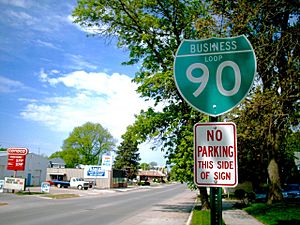
Transportation
Airports
Austin is served by the Austin Municipal Airport, a public-owned, public-use airport located on the east edge of the city. The nearest commercial international airports are located in Rochester (RST), 35 miles away, and the Twin Cities (MSP), 95 miles distant.
Bus and mass transit
Southern Minnesota Area Rural Transit provides bus transit within Austin and Mower County; daily routes, as well as on-demand pick-up and drop-off service is available. Rochester City Lines provides daily bus transportation between Austin and Rochester. For travel within the city, there is also local taxi service available.
Major highways
Austin is located at the intersection of Interstate 90 and U.S. Route 218. Minnesota State Highway 105 runs from Austin south to Iowa.
 Interstate 90
Interstate 90 U.S. Route 218
U.S. Route 218 Minnesota State Highway 105
Minnesota State Highway 105
Rail
Austin was once a railroad town. It was a division point and the site of car shops for the Milwaukee Road, five lines of which met in Austin. The community was also served by the Chicago Great Western's north–south mainline for trains between the Twin Cities and Omaha. All lines served passengers, and the Milwaukee Road Depot was a busy station ferrying travelers to and from Austin. Passenger rail service on the Milwaukee Road through Austin between Calmar, Iowa and St. Paul ended in 1953, and Pullman sleeper service on the Milwaukee between Austin and Chicago ended in 1960. An overnight train on the Chicago Great Western between the Twin Cities and Omaha called at Austin, with the southbound coming through late in the evening and the northbound train stopping early in the morning. This train last ran on September 30, 1965, ending all passenger train service to Austin. Freight service continues on the former Milwaukee Road mainline on that railroad's successor, the Iowa, Chicago and Eastern Railroad, a subsidiary of Canadian Pacific, but the Chicago Great Western was abandoned and torn up after the Chicago and North Western Railway acquired it in 1968.
Trails
Austin has an extensive network of paved recreational trails for biking and hiking. There are several miles of bike paths extending north to Todd Park and the Jay C. Hormel Nature Center. There is also a mountain biking trail, completed in 2015, that hosted a Minnesota High School Cycling League competition in its inaugural year.
Extensions to these existing non-motorized trails will connect Austin to the Blazing Star Trail (west toward Albert Lea and Myre-Big Island State Park) and the Shooting Star State Trail (east toward Rose Creek, Adams, and Leroy). The resulting trail system will be one of southern Minnesota's largest and was scheduled to be completed by 2018.
Notable people
- Marc Anderson, musician
- Josh Braaten, actor
- Philip Brunelle, conductor, primarily of choral music
- Trace Bundy, instrumental acoustic guitar player
- James W. Davidson, explorer, writer, diplomat, and philanthropist
- Richard Eberhart, United States Poet Laureate
- Shannon Frid-Rubin, violinist in Cloud Cult
- Jason Gerhardt, actor
- Jackie Graves, boxer
- Burdette Haldorson, basketball player and Olympian
- Charles Robert Hansen, businessman, mayor of Austin, Minnesota, and Minnesota state senator
- Vince Hanson, basketball player
- Amanda Hocking, writer of paranormal romance young adult fiction
- Geordie Hormel, musician, composer, founder/owner of The Village Recorder music studio in Los Angeles
- George A. Hormel, Founder of Hormel Foods
- James C. Hormel, United States Ambassador to Luxembourg, philanthropist, author
- Jay Catherwood Hormel, president of Hormel Foods 1929–1954; son of founder George A. Hormel
- Craig Hutchinson, film director and screenwriter
- Hope Jahren, geochemist and geobiologist
- Lee Janzen, professional golfer
- Molly Kate Kestner, musician
- Matthew Griswold, songwriter and musician
- Larry Kramer, football player and coach
- Tom Lehman, professional golfer
- John Madden, former Oakland Raiders head coach, NFL commentator, and member of the Pro Football Hall of Fame
- John Maus, musician
- Helen E. McMillan, Minnesota state legislator
- Patrick Moore professional golfer
- Wilbur Moore, professional football player
- Bob Motzko, University of Minnesota head men's ice hockey coach
- Tim O'Brien, novelist
- Charlie Parr, musician
- Pat Piper, politician
- Jeanne Poppe, member of the Minnesota House of Representatives
- Leo J. Reding, politician
- William Pitt Root, poet
- Frank Twedell, professional football player
- Wally Ulrich, professional golfer
- Sheldon B. Vance, Ambassador to Zaire
- Bree Walker, radio talk show host, actress, and disability-rights activist
- Robert B. Westbrook, historian
- Michael Wuertz, former Major League Baseball Pitcher with the Chicago Cubs and Oakland Athletics
- Martin Zellar, musician and songwriter
Images for kids
See also
 In Spanish: Austin (Minnesota) para niños
In Spanish: Austin (Minnesota) para niños






